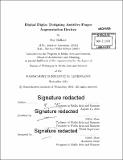Digital digits : designing assistive finger augmentation devices
Author(s)
Shilkrot, Roy
DownloadFull printable version (22.29Mb)
Alternative title
Designing assistive finger augmentation devices
Other Contributors
Massachusetts Institute of Technology. Department of Architecture. Program in Media Arts and Sciences.
Advisor
Pattie Maes.
Terms of use
Metadata
Show full item recordAbstract
Wearable computers are becoming a widespread reality. Driven by a quest for sensorial ultrability (ultra-ability) and control of our environment and bodies, we search for ever more intimate solutions to increase our innate physical capacities using technology. Finger-wearable devices for augmentation are nowadays part of the mainstream wearable fashion and research agenda, because of their uniquely convenient placement on the human body and proximity to the most expressive of limbs - the fingers. This thesis proposes a consideration of finger augmenting devices as a new class of instruments, rather than an opportunistic approach for positioning sensors and actuators. Out of a comprehensive survey of the work on finger augmentation, I put forward a definition for finger augmentation, a classification framework, and design guidelines for creating new finger-worn devices. I present four designs of finger-augmenters, their technical underpinnings, evaluation methods and theoretical contributions. Assistance is ubiquitous throughout the spectrum of technological benefit, advancing those with specific needs for recovery or rehabilitation, as well as those looking to go beyond human ability. This cross-cutting design principle for human-computer interfaces is uncontested yet underutilized. This thesis conceptualizes the Assistive Augmentation spectrum as a metaphor for the flexible interpretability of technology to simultaneously help many communities. The concrete prototypes I hereby present: EyeRing, FingerReader, Mobile-FingerReader and MusicReader, exemplify this idea and suggest an inclusive path of technology development.
Description
Thesis: Ph. D., Massachusetts Institute of Technology, School of Architecture and Planning, Program in Media Arts and Sciences, 2015. Cataloged from PDF version of thesis. Includes bibliographical references (pages 194-213).
Date issued
2015Department
Program in Media Arts and Sciences (Massachusetts Institute of Technology)Publisher
Massachusetts Institute of Technology
Keywords
Architecture. Program in Media Arts and Sciences.